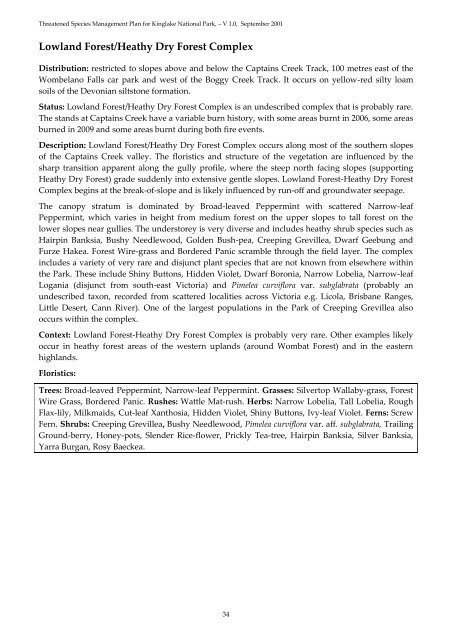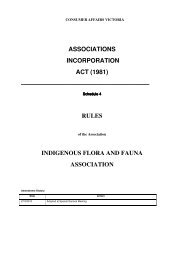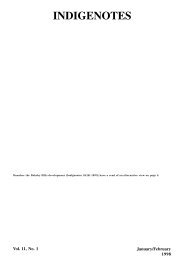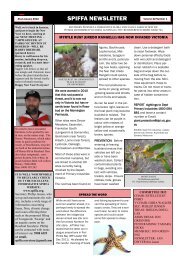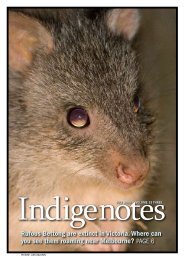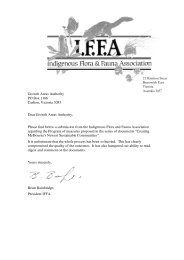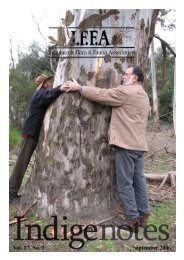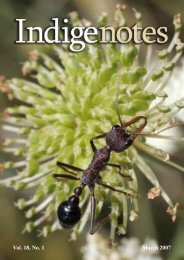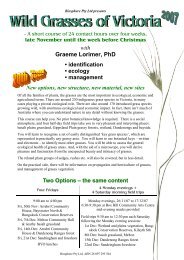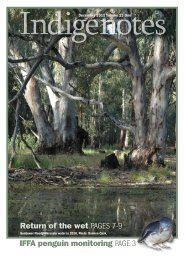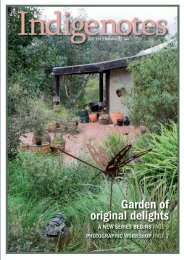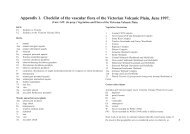Threatened Species Management Plan for Kinglake National Park
Threatened Species Management Plan for Kinglake National Park
Threatened Species Management Plan for Kinglake National Park
Create successful ePaper yourself
Turn your PDF publications into a flip-book with our unique Google optimized e-Paper software.
<strong>Threatened</strong> <strong>Species</strong> <strong>Management</strong> <strong>Plan</strong> <strong>for</strong> <strong>Kinglake</strong> <strong>National</strong> <strong>Park</strong>, – V 1.0, September 2001<br />
Lowland Forest/Heathy Dry Forest Complex<br />
Distribution: restricted to slopes above and below the Captains Creek Track, 100 metres east of the<br />
Wombelano Falls car park and west of the Boggy Creek Track. It occurs on yellow-red silty loam<br />
soils of the Devonian siltstone <strong>for</strong>mation.<br />
Status: Lowland Forest/Heathy Dry Forest Complex is an undescribed complex that is probably rare.<br />
The stands at Captains Creek have a variable burn history, with some areas burnt in 2006, some areas<br />
burned in 2009 and some areas burnt during both fire events.<br />
Description: Lowland Forest/Heathy Dry Forest Complex occurs along most of the southern slopes<br />
of the Captains Creek valley. The floristics and structure of the vegetation are influenced by the<br />
sharp transition apparent along the gully profile, where the steep north facing slopes (supporting<br />
Heathy Dry Forest) grade suddenly into extensive gentle slopes. Lowland Forest-Heathy Dry Forest<br />
Complex begins at the break-of-slope and is likely influenced by run-off and groundwater seepage.<br />
The canopy stratum is dominated by Broad-leaved Peppermint with scattered Narrow-leaf<br />
Peppermint, which varies in height from medium <strong>for</strong>est on the upper slopes to tall <strong>for</strong>est on the<br />
lower slopes near gullies. The understorey is very diverse and includes heathy shrub species such as<br />
Hairpin Banksia, Bushy Needlewood, Golden Bush-pea, Creeping Grevillea, Dwarf Geebung and<br />
Furze Hakea. Forest Wire-grass and Bordered Panic scramble through the field layer. The complex<br />
includes a variety of very rare and disjunct plant species that are not known from elsewhere within<br />
the <strong>Park</strong>. These include Shiny Buttons, Hidden Violet, Dwarf Boronia, Narrow Lobelia, Narrow-leaf<br />
Logania (disjunct from south-east Victoria) and Pimelea curviflora var. subglabrata (probably an<br />
undescribed taxon, recorded from scattered localities across Victoria e.g. Licola, Brisbane Ranges,<br />
Little Desert, Cann River). One of the largest populations in the <strong>Park</strong> of Creeping Grevillea also<br />
occurs within the complex.<br />
Context: Lowland Forest-Heathy Dry Forest Complex is probably very rare. Other examples likely<br />
occur in heathy <strong>for</strong>est areas of the western uplands (around Wombat Forest) and in the eastern<br />
highlands.<br />
Floristics:<br />
Trees: Broad-leaved Peppermint, Narrow-leaf Peppermint. Grasses: Silvertop Wallaby-grass, Forest<br />
Wire Grass, Bordered Panic. Rushes: Wattle Mat-rush. Herbs: Narrow Lobelia, Tall Lobelia, Rough<br />
Flax-lily, Milkmaids, Cut-leaf Xanthosia, Hidden Violet, Shiny Buttons, Ivy-leaf Violet. Ferns: Screw<br />
Fern. Shrubs: Creeping Grevillea, Bushy Needlewood, Pimelea curviflora var. aff. subglabrata, Trailing<br />
Ground-berry, Honey-pots, Slender Rice-flower, Prickly Tea-tree, Hairpin Banksia, Silver Banksia,<br />
Yarra Burgan, Rosy Baeckea.<br />
34


